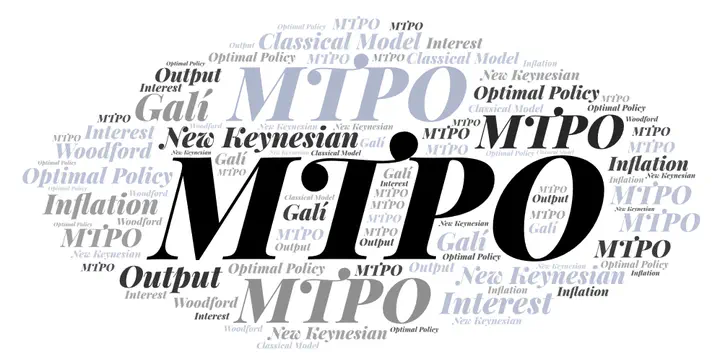Monetary Theory and Policy (MTPO)
 Created using https://wordart.com/
Created using https://wordart.com/This course introduces students to the dynamic stochastic general equilibrium (DSGE) models used in modern monetary macroeconomics called New Keynesian models at the master’s level. The basic model equations including nominal frictions such as price stickiness are derived carefully, and model solution techniques are discussed. Numerical solutions of the models are obtained and the models are simulated and analyzed using Dynare in MATLAB. Possible extensions to the core model that may be treated in class include an analysis of optimal monetary policy and the accelerator mechanism.
After completing the course, students should understand the dynamic mechanisms of nominal rigidities and the policy tradeoffs facing monetary policy. Mechanically, students will be able to derive, solve and simulate simple DSGE models and should be able to read and understand more elaborate models found in the literature.
Literature: Barro, Robert and David Gordon (1983): “Rules, discretion and reputation in a model of monetary policy,” Journal of Monetary Economics, 12(1), pp. 101-121. Clarida, Richard, Jordi Galí, and Mark Gertler (1999): “The Science of Monetary Policy: A New Keynesian Perspective,” Journal of Economic Literature, American Economic Association, vol. 37(4), pp. 1661-1707. Galí, Jordi (2008): Monetary Policy, Inflation, and the Business Cycle: An Introduc-tion to the New Keynesian Framework. Princeton University Press. King, Robert and Watson, Mark, (1995), Money, prices, interest rates and the busi-ness cycle, No 95-10, Working Paper Series, Macroeconomic Issues, Federal Reserve Bank of Chicago. Lucas, Robert E. (1976): “Econometric Policy Evaluation: A Critique,” Carnegie-Rochester conference Series on Public Policy, vol. 1, 19-46. McCandless, George (2008): The ABCs of RBCs: An Introduction to Dynamic Mac-roeconomic Models. Harvard University Press. Sims, Christopher (1980):“Macroeconomics and Reality,” Econometrica, 48(1), 1-48. Woodford, Michael (2001): “The Taylor Rule and Optimal Monetary Policy,” Ameri-can Economic Review 91(2), pp. 232-237.
Course Outline
Introduction Concepts/techniques: Real Business Cycles versus New Keynesianism Main readings: Galí (2008), ch. 1 Additional reading: Lucas (1976), Sims (1981)
A Classical Monetary Economy Concepts/techniques: Intertemporal optimization, monetary neutrality, log linearization Main reading: Galí (2008), ch. 2 Additional reading: King and Watson (1995)
The Basic New Keynesian Model Concepts/techniques: Staggered price setting, equilibrium determination Main reading: Galí (2008), ch. 3 Additional reading: Clarida et al. (1999)
Optimal Policy Design Concepts/techniques: Policy efficiency, optimal versus simple policy rules Main reading: Galí (2008), ch. 4 Additional reading: Woodford (2001)
Discretion versus Commitment Concepts/techniques: Time consistency Main reading: Galí (2008), ch. 5 Additional reading: Barro and Gordon (1983)
share: false